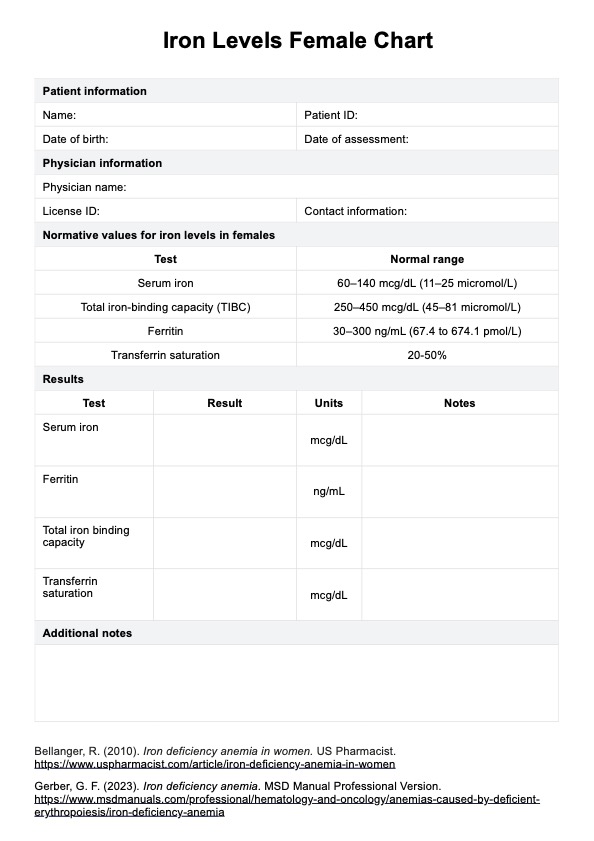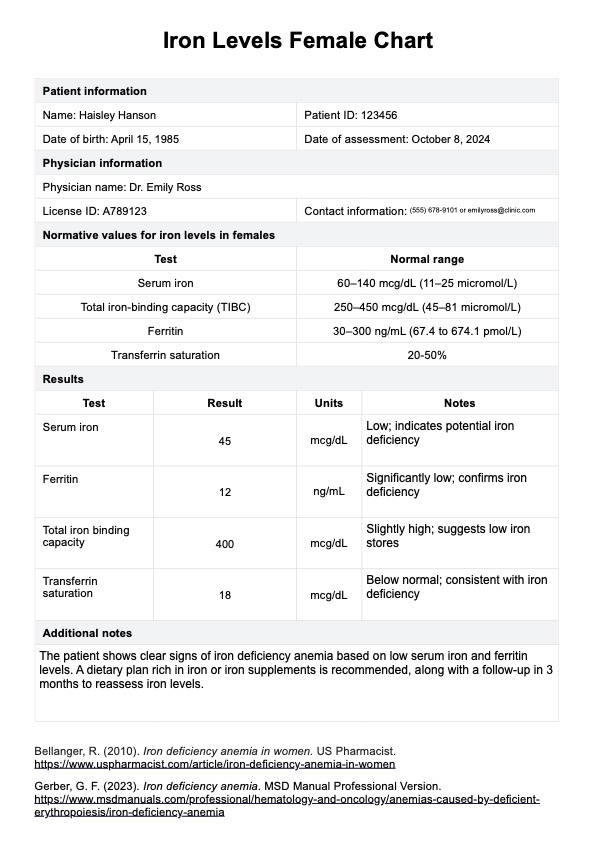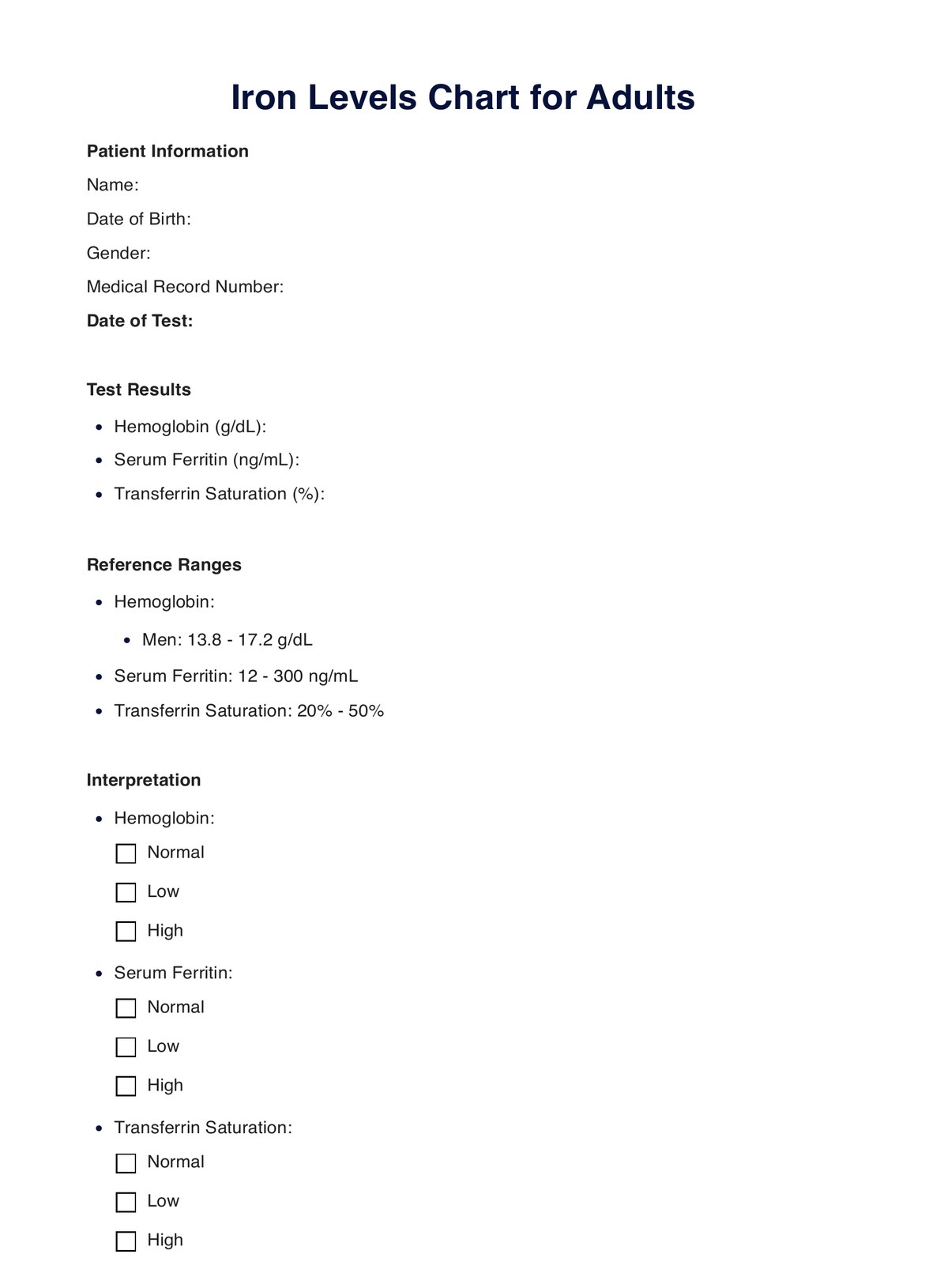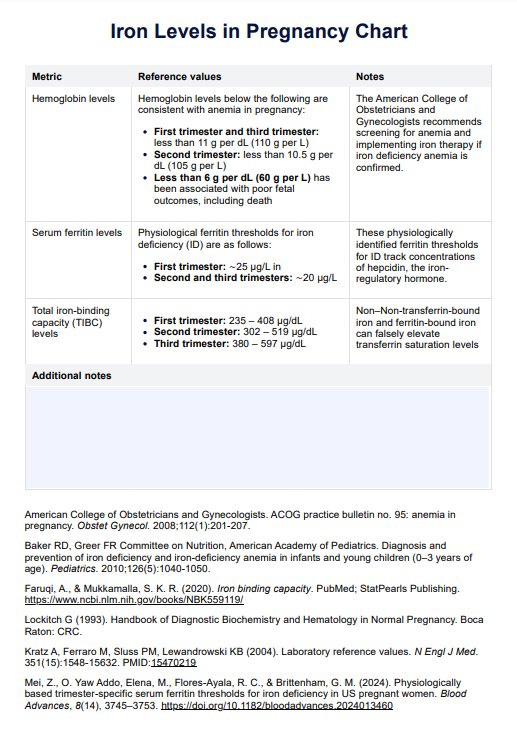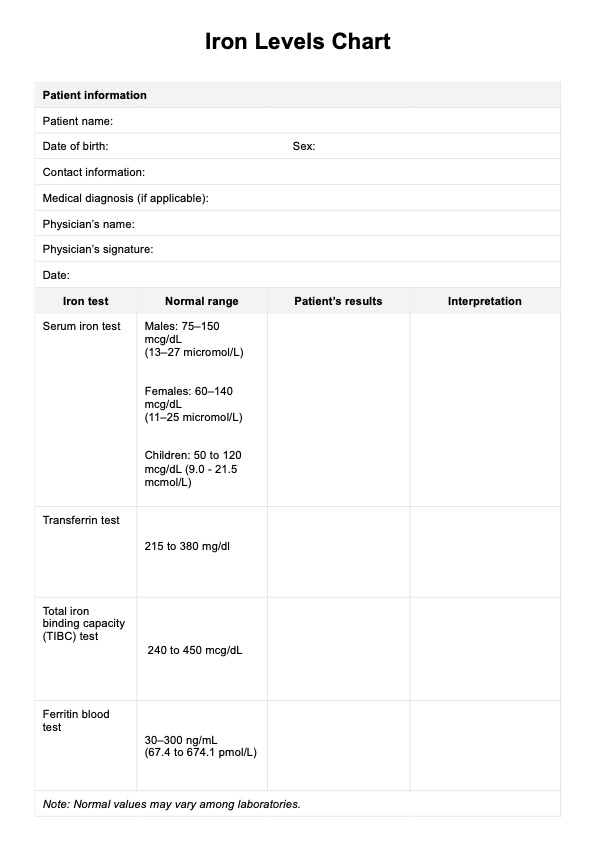Iron Levels Female
Assess iron levels in female patients, track symptoms, and make guided tailored treatment plans with the Iron Levels female Chart. Download now!


What are iron levels?
Iron levels refer to the amount of iron present in the blood, which is essential for producing red blood cells that carry oxygen throughout the body. Measured in mcg/dL, iron levels help assess the body’s ability to store and use iron effectively. Low iron levels often indicate iron deficiency, which, if left untreated, can lead to iron deficiency anemia, which causes fatigue, weakness, and other health complications. Medical professionals measure serum iron to evaluate iron levels, and treatments may include dietary iron therapy or iron supplements and vitamin C to restore balance and prevent further complications.
Female vs. male iron levels
Iron levels in females and males differ due to various physiological factors. Women typically have lower blood iron levels than men because of menstruation, pregnancy, and hormonal fluctuations, which can deplete iron stores. This makes women more prone to iron deficiency anemia. Women's average serum iron level ranges between 60-140 mcg/dL, while men often fall on the higher end of this range at 75-150 mcg/dL. Women also need more elemental iron to compensate for blood loss and maintain normal iron levels. Men tend to have more red blood cells and, therefore, higher iron storage in their bone marrow.
Men's bodies also generally absorb iron better, while women, particularly during pregnancy or menopause, may experience decreased iron absorption. Health professionals monitor total and serum iron-binding capacity to assess these levels. Severe cases may require blood transfusions, while milder forms, like moderate iron deficiency anemia, are treated with supplements based on how much iron the body needs.
Iron Levels Female Template
Iron Levels Female Example
What is an Iron Levels Female Chart?
An Iron Levels Female Chart is a tool used to assess and track iron levels for women based on specific health markers. It provides information on a woman's normal iron level, typically between 60 and 140 mcg/dL, and helps determine a low iron level, which may signal iron deficiency. This also includes normative values for total-iron binding capacity, ferritin, and transferrin saturation.
Through this chart, women found with low serum iron levels or depleted total body iron stores may receive the appropriate treatment with iron supplements such as oral iron or intravenous options such as iron dextran, iron sucrose, or sodium ferric gluconate.
This chart can then be helpful in proper diagnosis, ensuring the body can efficiently absorb iron and maintain healthy red blood cells without developing too much iron.
How does it work?
Medical professionals can effectively use Carepatron's Iron Levels Female Chart to monitor and manage their patients' iron levels. This easy-to-use tool aids in diagnosing iron deficiencies, tracking iron levels over time, and implementing treatment plans to restore optimal health.
Access the chart template
This guide contains Carepatron’s Iron Levels Female Chart. The chart is designed for quick and easy use and provides an efficient way for healthcare providers to track iron levels, compare them to normal ranges, and diagnose issues such as iron deficiency anemia.
Review the components of the template
Before using the template, review its key components, including fields for serum iron, ferritin levels, and other important metrics. Ensure you understand the normal and abnormal values to accurately interpret results and make informed decisions about a patient’s iron health.
Introduce and use the template with the patient
Introduce the Iron Levels Female Chart to the patient, explaining its purpose in monitoring their iron health. Record the patient’s iron levels, compare them to established norms, and discuss any concerns, such as low or dangerously high values. The chart helps guide treatment plans, including iron supplementation or therapy.
Address concerns
Patients may have concerns about their iron levels, especially if the results are abnormal. Use the chart to explain their current status and clarify what low or high levels mean. Based on their results, offer reassurance about treatment options, whether through dietary changes, iron supplements, or further medical tests.
Provide patient education and next steps
Once the chart is reviewed, educate the patient on maintaining healthy iron levels. Discuss proper nutrition, iron absorption, and any necessary treatments. Outline the next steps, which may involve follow-up appointments, lifestyle adjustments, or additional testing to ensure their normal iron levels stay within a healthy range.
When should medical professionals use this chart?
Medical professionals should use the Iron Levels Female Chart when evaluating patients with symptoms or risk factors related to iron deficiency or iron deficiency anemia. The chart helps monitor normal blood iron values, allowing for an accurate diagnosis of iron deficiency. It’s particularly useful for patients with conditions that affect iron absorption, such as inflammatory bowel disease or other gastrointestinal disorders that impact how the body absorbs iron, or in cases of excessive blood loss, where blood volume decreases, and frequent blood transfusions are needed.
Tracking iron levels is essential for women experiencing fatigue, weakness, or other anemia-related symptoms. The chart enables healthcare providers to assess normal iron levels, review red blood cells, and evaluate the patient’s response to supplemental iron or oral iron therapy. It also guides decisions on iron treatments, including using iron salts and heme iron, which the body absorbs more efficiently. Additionally, it tracks how much iron the patient needs and if further interventions, such as increasing protein to help store iron, are required.
Commonly asked questions
A good iron level for a woman typically ranges from 60 to 140 mcg/dL. These levels indicate sufficient iron stores for maintaining overall health and supporting the production of healthy red blood cells.
Iron below 60 mcg/dL can be concerning, as it may indicate iron deficiency or an increased risk of developing iron deficiency anemia. Monitoring these levels closely and considering further evaluation or treatment is essential.
Yes, an iron level of 12 mcg/dL is considered low and may signal the presence of iron deficiency. This low level could result in symptoms like fatigue and weakness, necessitating further assessment and potential treatment.
Low iron levels are generally indicated by serum iron readings below 60 mcg/dL. Additionally, ferritin levels below 30 ng/mL are often used as a marker for depleted iron stores, suggesting intervention is needed.


